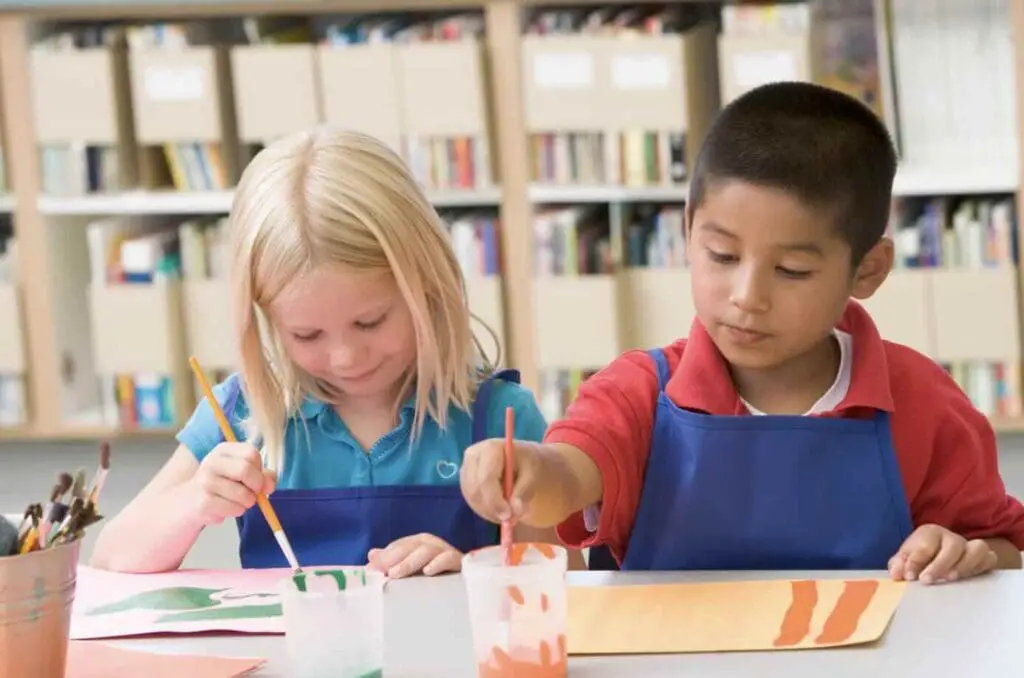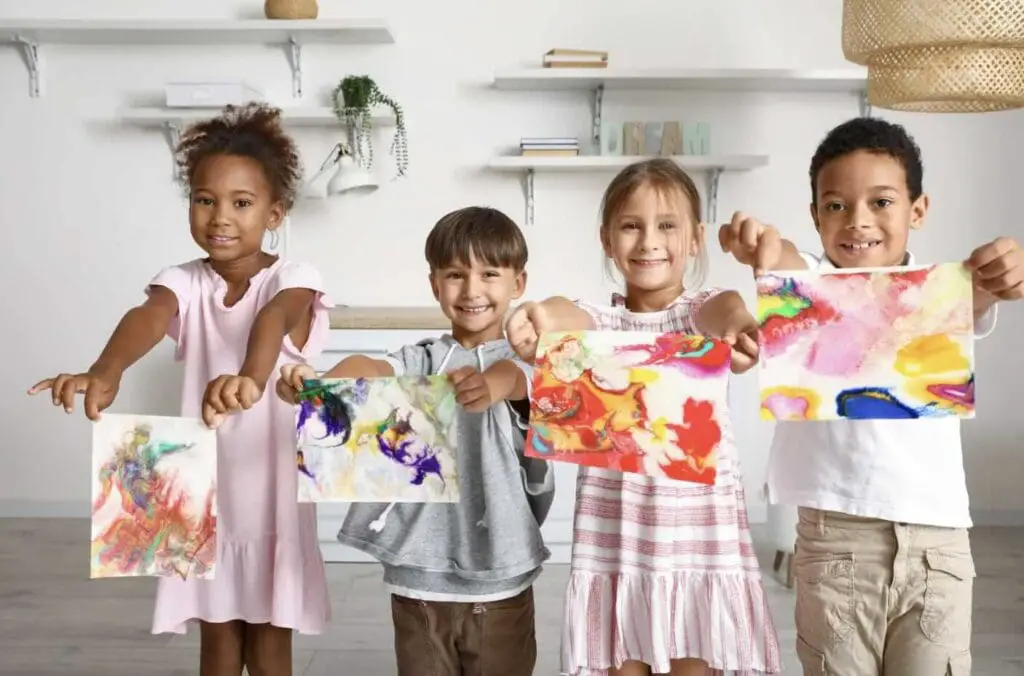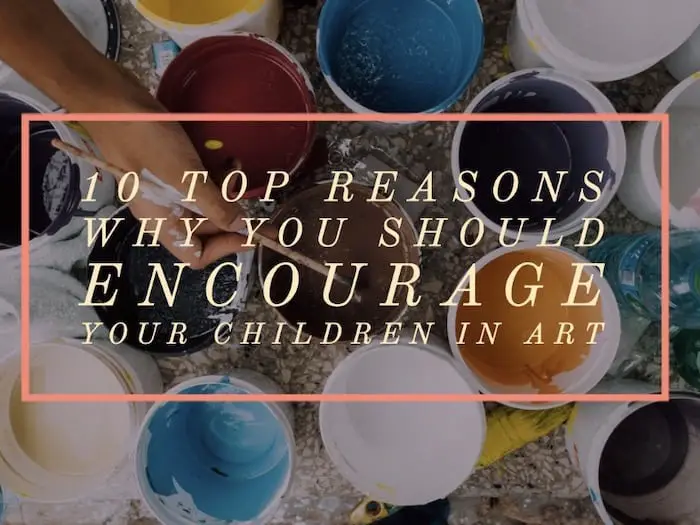Painting and art are some of the creative areas of life that every child (and adult) should try to explore. The great thing about art is that the pursuit of art comes with many excellent fringe benefits that you may not even realize.
Some of the benefits of art include increased creativity, better hand-to-eye coordination, clearer self-expression, increased decision-making skills, improved visual-spatial skills, the teaching of perseverance, it helps boost your focus, you learn to see the world differently, it helps to build self-confidence, and it is just plain fun.
Table of Contents
- 10 Compelling Reasons to Foster Artistic Growth in Children
- Frequently Asked Questions
- Related Questions
10 Compelling Reasons to Foster Artistic Growth in Children
Engaging in painting and art is a valuable exploration for children and adults alike, offering a realm of creative expression that is both enriching and educational. Art isn’t just an outlet for creativity; it brings many benefits that might not be immediately apparent.
These advantages range from enhancing creativity and hand-eye coordination to fostering clear self-expression and decision-making skills. Art also improves visual-spatial abilities, teaches perseverance, sharpens focus, offers new perspectives on the world, builds self-confidence, and is an enjoyable activity.
Encouraging children to delve into the arts is a gift that keeps giving, contributing significantly to their personal and cognitive development.

Here are our 10 Top Reasons Why You Should Encourage Your Children in Art and why you should also learn to Paint:
Art Builds Creativity
Art and the process of art are all about learning to be creative. It allows us to express ourselves in a way that science or math does not allow us to. It is through our learning of art that each of us is able to think more creatively and also learn how to solve problems creatively.
It was Pablo Picasso who so very wisely told us:
“Every child is an artist; the problem is staying an artist when you grow up.”
Pablo Picasso
Art Helps Hand-to-eye Coordination
Do your children have difficulty catching a ball or have extremely messy handwriting? Drawing, painting, and art, in general, help children develop a steady hand. This can help them learn how to handle and hold a pen or pencil properly.
The Philly Art Center said this about how art helps children:
“One of the most important skills that are developed through art is fine motor development. During art lessons, your child’s small muscles in the fingers, hands, and wrists are exercised and strengthened, helping to make learning to write easier.”
philly art Center
Art Explores Self-Expression
We are all unique. Each child is also amazing. And art is a way for all children, even those of us who are older and all grown up, to express ourselves. Our art should be an extension of who we are.
This is one of the great things about art and also studying artists that have gone before us. We can see so much of their personality and who they are in their art.
Kurt Vonnegut reminds us all why we should have some form of art in our lives:
“To practice any art, no matter how well or how badly, is a way to make your soul grow, for heaven’s sake. So do it.”
Kurt Vonnegut
Art Promotes Decision-making Skills
Painting and creative expression allow children to develop their decision-making skills. In painting, a child needs to plan and decide what they will paint and why. They then need to decide and choose what colors they will use and why they will use them. All of these kinds of activities help children to improve their decision-making skills.
When children sit down with paper and paints, they use their decision-making skills to decide what they will paint and why. Alfie Kohn, who wrote the book Unconditional Parenting: Moving from Rewards and Punishments to Love and Reason, says why this kind of decision-making is so essential to every child’s development:
“The way kids learn to make good decisions is by making decisions, not by following directions.”
Alfie Kohn
Art Helps Visual Learning
Art is all about the visual aspects, which also includes visual learning. This is why drawing, painting, and sculpting in an art class or even as an at-home activity will help children fully develop their visual-spatial skills.
Visual-spatial skills are important for children to learn as having these skills can affect many aspects of their lives:
“People with Visual/Spatial intelligence are very aware of their surroundings and are good at remembering images. They have a keen sense of direction and often enjoy maps. They have a sharp sense of space, distance, and measurement.”
personality max
Some people have natural abilities when it comes to their visual-spatial skills. Those people who have good visual-spatial skills. Are usually good at things such as:
- They notice colors, shapes, and forms around them.
- I can visualize just about anything.
- Very good at visual puzzles
- They enjoy things such as geometry.
- They love to draw and paint.
- They enjoy photography
- Appreciate books with pictures and tend to see pictures more than words.
- Usually very good with directions
- Remembers places vividly and can recall them.
- Good at all kinds of artistic composition and expression.
If you or your child does not naturally have these abilities, art can help you develop or improve your visual-spatial skills.

Art Teaches Perseverance
Learning any art can be a challenge. It takes a lot of time, patience, and hard work. Being involved in any art form means you must practice and work at it consistently.
This is why art teaches a child not to quit but to keep going. It is a lesson they can take with them throughout their lives, and they can realize that when they come across something hard, they can make it through those tough times and persevere.
I love this quote by the great artists Van Gogh on painting even when you think you can not paint:
“If you hear a voice within you say, ‘You cannot paint,’ then by all means paint, and that voice will be silenced.”
Vincent Van Gogh
Art Helps You Focus
Painting helps your focus. When you paint, you need to look at all the details of the painting. This allows you to focus on the painting and to concentrate on it.
When painting, I often put my painting where I can view it from a distance. I will concentrate on the painting by looking at it and thinking about the details of it. All of this is a form of focus and concentration.
As Gaye Adams said about painting:
“The daily small painting, a small resource and time commitment, is an exercise in absolute focus for that time period. It’s like a meditation, really.”
Gaye Adams
Art Helps Us See the World Differently
When you start to paint the one thing it does, it opens up the world in another way. This also happens to children when they paint. Maybe they no longer just see the sun, but they see the sun, their home, or their family in a new way.
Art helps your power of observation. Artists start to observe the world in the way they want to paint it. They no longer see a pink flower, but they see it as how they want to paint it.
Cicero said this about art and the power of observation:
“Art is born of the observation and investigation of nature .”
cicero
Art Builds Self-Confidence
True art is subjective. As they say, beauty is in the eyes of the beholder. That is why art is such a great self-confidence booster for children.
Art also helps with self-confidence as it is a way for children to communicate their emotions, frustrations, and feelings safely. They can communicate and express themselves through the use of colors and objects. They do not need to use any words.
When a child feels they have done a great job on the painting and they are proud of it, it also helps them to do other things well, as we are reminded in this quote:
“Have confidence that if you have done a little thing well, you can do a bigger thing well too.”
Healthyplace.com
Art Is Fun!
Art at any age is a fun thing to do. It is a form of self-expression, so you can make your art whatever you want. Rules can be broken—new techniques are tried and tested. New forms of expression learned.

Ai Weiwei reminds us all that life is filled with art when he says:
“Life is art. Art is life. I never separate it.”
Ai Weiwei
Art is a great activity for children and an amazing thing anyone can start doing at any age. Not only is it a fun thing to do, but it also has a lot of added benefits for your overall health and well-being.
Anita Louise Art is dedicated to art education, great artists, and inspiring others to find and create their art. We love art that uplifts and inspires. #ArtToMakeYouSmile! #ArtToMakeYouHappy!
If you want to see any of my art, you can find out more by clicking here. If you are interested in what inspires me and my paintings, you can discover more by clicking here.
We have a free newsletter and would love you to be part of our community; you can subscribe to the newsletter by clicking here. If you have any questions, I would be happy to talk to you anytime. You can reach me, Anita, by clicking here.
Subscribe to our Anita Louise Art YouTube Channel with great videos and information by clicking here.
Join us for our podcast “5 Minutes With Art.”Spend 5 minutes a week with us to discover and learn about great art and artists. You can find out more about our podcast by clicking here.
Frequently Asked Questions
Why is encouraging my child in art important?
Encouraging your child in art is essential because it fosters increased creativity, helping them think outside the box and find innovative solutions in various aspects of life.
How does art enhance hand-to-eye coordination in children?
Engaging in art activities requires fine motor skills, which in turn enhance hand-to-eye coordination. This can be especially beneficial for children in their early developmental stages.
What role does art play in promoting clearer self-expression?
Art provides a non-verbal outlet for self-expression, allowing children to convey their thoughts and emotions in a visual and imaginative way, promoting clearer communication.
Can art really improve decision-making skills in children?
Yes, creating art involves making choices about colors, shapes, and forms. This decision-making process helps children develop critical thinking skills and make confident decisions in other aspects of their lives.
How does art contribute to improved visual-spatial skills?
Engaging in artistic activities, such as drawing and painting, enhances a child’s ability to perceive and understand spatial relationships, which is crucial for tasks like reading maps and solving geometric problems.
How does art teach perseverance to children?
The process of creating art often involves overcoming challenges and setbacks. This helps children learn the value of persistence, resilience, and the satisfaction of completing a task they initially found difficult.
In what ways does art boost focus in children?
Art requires concentration and attention to detail. Engaging in artistic activities helps children develop the ability to focus on a task, which can positively impact their academic performance and other areas of life.
How does art help children see the world differently?
Art encourages children to observe their surroundings with a creative and open mind. It helps them appreciate the beauty in everyday things and view the world from diverse perspectives.
How does art contribute to building self-confidence in children?
Successfully completing art projects and receiving positive feedback can boost a child’s self-esteem and confidence. This sense of accomplishment carries over into other aspects of their lives.
Is art beneficial for children purely because it is fun, or are there deeper benefits?
While art is undeniably enjoyable, its benefits extend beyond mere enjoyment. It enhances cognitive skills, emotional intelligence, and overall well-being, making it a valuable and holistic developmental activity for children.
Related Questions
What Are Some Traits An Artist Should Acquire?
Some of the traits that any artist should try to acquire are having inspiration, learning the power of observation, having the ability to develop a good memory, and having an imagination. It is also good to create the art of persistence and patience along with self-discipline. And finally, if an artist can see life as a great adventure, it will help them in life and in their artwork and make it fun.
To find out more about the traits that every artist should acquire, you can read our blog 9 Traits That Are Important for Any Artist to Acquire by clicking here.
Why Start Oil Painting?
You should consider oil painting over other paint mediums for many reasons. The 5 top reasons to use oil paints are: 1) the vibrancy of the colors you can obtain from oils, 2) they mix well with other paints and other mediums, 3) oil paints have amazing color blending properties 4) the slow drying process of oil paints gives added control and 5) oil painting has been done for centuries.
To find out more about starting to oil paint, you can read our blog on Why Start Oil Painting? The Top 5 Reasons Why by clicking here.

